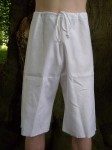Shirts were simple t-shaped garments with either a plain round neck or, in the 15thC, a simple split neck opening. They were rarely seen except on labouring class men working in hot conditions (though most often depicted in execution scenes). Made of linen so that they could be frequently laundered, the quality of the fabric depended on the wealth of the owner, as did the colour; fine, white linen was the choice of the wealthy, natural brown/grey heavier cloth was more affordable to working class men. Even the poorest man would have owned several shirts and they would have doubled as nightwear.
Plain neck shirt £45
Split neck shirt, hand-finished £55
 Long Leg (Pipe) Braies |
Braies (or Breeches) were the innermost layer of mens clothing. They fill in the gap between single leg hose in the 13th and 14th centuries. As hose became fuller, braies got smaller.There are no surviving examples of braies as linen rots away too quickly. All these examples are “best guesses” worked out from pictorial evidence.
Long leg braies were worn between single leg hose. “Boxer” braies are an alternative pattern for the same garment, with less fullness in the rear.
15th century braies are worn under joined hose, the Italian braies are seen in paintings from the end of the 15th century.
Braies £35 |
 “Boxer” braies |
 15th Century Braies |
|
 15th Century Italian Braies |
Related Searches: 13th Century, 14th Century, 15th Century, Menswear

Shifts and hose are the foundations of womenswear throughout much of history.
Shifts were linen under-garments very similar to mens shirts, just longer and fuller. In the 13th, 14th and 15th century nothing was worn underneath the shift.
Women’s hose were knee-length socks cut from woven cloth. They were often quite loose and held up by garters just below the knee.
Linen shifts £65
Half-hose in linen or wool £45

Ladies Half-Hose
Related Searches: 13th Century, 14th Century, 15th Century, Hose, Shift, Womenswear





